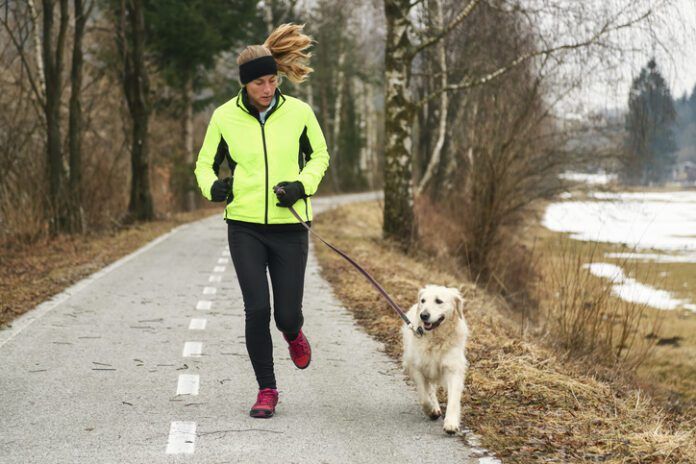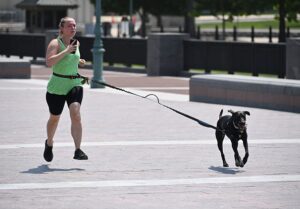
There are countless benefits to running with your dog: Running or jogging will help maintain your dog’s weight, improve his muscle tone, maintain a strong cardiovascular system, and build endurance. Running uphill develops rear drive. If you compete in any sort of showing or sport with your dog, he will undoubtedly become better conditioned from running than his “weekend warrior” competitors.
Running is also beneficial to your dog’s mental health. Running makes dogs happy. It allows them to explore the world through sights, sounds, and smells. They get to spend more time with you doing something fun. It allows them to release energy, making it less likely that they will vent their energy in destructive ways. This will make you happy.
Check with your vet first
Before you start running with your dog, however, he should be examined by your veterinarian and cleared to start a running program before you subject him to many miles. (If you are just beginning running yourself, it is advisable to have a physical examination by your doctor, too!)
How old should your dog be before it is physically safe to begin running together? One rule of thumb is that the dog’s bone growth plates should be closed before the dog takes part in any sort of rigorous activity. Puppy bones and muscles need sufficient time to develop fully and may be injured by beginning a structured running program too early. Some breeds and types mature more slowly than others. Owners of large dogs such as Great Danes and Scottish Deerhounds, for example, may be well advised to wait until their dogs reach the age of 1½ to 2 years. Lighter-boned dogs such as Miniature Pinschers and Whippets may be ready at 8 months to a year. Most dogs should be in the 1- to 1½-year range; check with your veterinarian for information on when your dog’s bone growth plates should be expected to close.
Training preparation
Before you begin running with your dog, you will need to train your dog to first walk, and then run with you. Your dog should already be trained to walk on leash without forging ahead and pulling you off balance, and should sit by your side when you stop at busy intersections. Teaching simple behaviors such as “slow” or “easy” when your dog pulls, or “leave it” when he spots a squirrel or rabbit, are imperative for your safety when running. Remember, unlike walking, only one of your feet is in contact with the ground when you are running, making your dog’s sudden pulls especially dangerous.
Necessary equipment
While you will need to invest in some properly fitting, quality running shoes, and perhaps some specific running attire for yourself, running gear for your dog is simple and inexpensive. All you need is a four-foot to six-foot leather or cotton web lead and a snugly fitting flat collar to keep your dog safely by your side. A flat collar, martingale collar, or head halter are all choices to consider. A harness is also an option, but the fit and quality of materials used in a dog running harness are critical, as harnesses can cause serious chafing on longer runs. Retractable leads are not recommended.
Start running with your dog slowly
Many of the same principles that apply to beginning a running program for humans apply to our dogs as well. Owners and dogs should ease gradually into a running program, beginning with alternating walking and running for brief periods (no more than 20 minutes), three times a week, gradually increasing the running. Humans and dogs new to running might begin with two minutes of running at a comfortable pace followed by two minutes of walking, for a week or two. Progress to four minutes of running, two minutes walking, then to six minutes running, two walking, until you and your dog are able to run continuously for 20 minutes comfortably, three times a week.
Begin all workouts with a warm-up period of brisk walking or easy jogging before running as well as a similar cool-down after your workout.
Rest and recovery are essential to improve the fitness of both you and your dog. When just starting out, run with your dog every other day, rather than on successive days, allowing time for muscle recovery and to avoid injury while building endurance.
After four to six weeks of training three times a week for 20 minutes, both you and your dog will have built up your strength and endurance to begin to increase your mileage. The generally accepted guideline on increasing running mileage is not to exceed a 10 percent increase (in either time or mileage) a week. As you increase your mileage, your dog’s pads will gradually toughen to handle the longer distances.
How far can your dog run?

As your dog’s strength and stamina increase, he will undoubtedly delight in accompanying you on longer training runs. The number of miles, minutes, or hours you eventually run with him is largely determined by the dog. Many breeds are capable of running 25 to 35 miles a week, but perhaps individual dogs within the breed are not. It is important for you to determine your dog’s limits when running. The dog’s age, size, body density, coat thickness, and temperament may affect how far your dog can safely run. Dogs, like humans, have physical and mental differences that influence performance. By observing your dog’s behavior it is simple to figure out your dog’s comfortable running distance.
The signs that your dog is tiring are often subtle, and his devotion to you may cause him to run longer or farther than he would on his own. It is up to you to recognize these subtle signs and to stop your run as soon as you become aware of them. If your dog is panting excessively, breathing fast and hard, lagging behind the length of the lead, or showing signs of lameness, it is time to abandon your training run. Be particularly aware of the behavior of the older dog when running. These veterans have not lost their enthusiasm, but just as older human athletes, they need to slow down a bit and need more time for rest and recovery.
Check the condition of your dog’s collar and leash before beginning a run. Replace frayed or cracked collars and leashes to ensure your dog’s safety.
Both you and your dog should run with identification in case of emergency. Check your dog’s tags regularly to make sure the writing is still legible.
Wear clothing that is visible to motorists, especially at night, duck, and dawn. Reflective running apparel is available for both you and your dog. Your choices include reflective leashes, collars, and vests, as well as flashing collars and flashing lights.
Begin your workouts with a warm-up (brisk walk or easy jog) and end with a cool-down to lower heart rates gradually.
Run facing traffic (a universal rule of running). Your leashed dog should run on your left side, away from traffic.
Make sure both you and your dog remain hydrated. On longer and warmer runs, carry water or plan your route to include several water stops.
Be conscious of your surroundings, including road conditions, traffic, other people, and other animals, to avoid injury and unpleasant or dangerous confrontations. No wearing headphones!
Don’t bring your dog when it’s hot, highly humid, or freezing. Dogs do not tolerate heat and humidity as well as humans and can easily suffer from heatstroke when running during the summer months. Prolonged exposure to frigid temperatures may lead to frostbite of unprotected areas (ears, paws, scrotum, and tail are particularly vulnerable) – and the chemicals, salt, and sand used to melt snow and ice on streets and sidewalks may irritate your dog’s feet. Always inspect your dog’s paws at the end of a run and wash off his feet, legs, and underside to remove any chemicals or salt that could be harmful to your dog if swallowed.
Pay attention to the surfaces you are asking your dog to run barefoot on! Running in cities and towns guarantees lots of miles on paved roads that will toughen your dog’s pads. Be careful not to do too much running on concrete sidewalks; it is an even harder surface to run on than asphalt and will take its toll on your legs. Living in the country, you may have access to dirt roads that are kinder on feet and joints (yours and your dog’s!).
Always clean up after your dog. Carry a minimum of two poop bags – on the day you bring just one, your dog will almost certainly poop twice.
Be aware of your dog’s behavior at all times. Watch for irregularities in gait, breathing, signs of heat exhaustion, waning enthusiasm, etc. If your dog shows signs of tiring, stop running.
Have fun! Not every run has to be a serious training run. Vary your running routes often, stop to smell the roses occasionally (or the fire hydrants perhaps), walk a little, let your dog explore, and enjoy your surroundings together.




